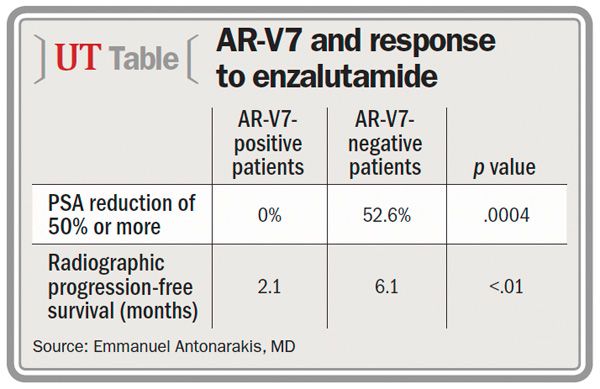Article
Protein may predict resistance to prostate cancer Tx
Author(s):
Researchers have come up with a potential blood-based biomarker that can identify men with castration-resistant prostate cancer who are not likely to respond to enzalutamide (XTANDI).
San Diego-Researchers have come up with a potential blood-based biomarker that can identify men with castration-resistant prostate cancer (CRPC) who are not likely to respond to enzalutamide (XTANDI).

A simple blood test that can detect the presence of the androgen receptor (AR)-V7 splice variant appears to predict non-response to this new therapy.
“Although enzalutamide is a highly effective drug for many men with advanced prostate cancer, about 21% failed to respond to this agent in the pivotal phase II AFFIRM trial. Our data show that AR-V7 seems to predict resistance to enzalutamide in virtually all cases. These findings are clinically relevant and can save both time and money, as oncologists could identify men likely to be resistant to this drug before they needlessly prescribe it. This could allow oncologists to steer men to other available therapies that are more likely to work,” noted lead author Emmanuel Antonarakis, MD, assistant professor of oncology at Johns Hopkins Sidney Kimmel Comprehensive Cancer Center in Baltimore.

Dr. AntonarakisHormones-including testosterone-are thought to drive prostate cancer by binding to the AR and fueling cancer growth and proliferation. AR-V7 is a shortened form of the AR protein. It lacks the ligand-binding domain that is the target of enzalutamide, but AR-V7 can still attach to cellular DNA and fuel growth and proliferation even without testosterone, Dr. Antonarakis explained.
Many mechanisms of resistance to enzalutamide have been proposed, he continued. Splice variants of the AR gene are only one of them.
“We have focused our research on AR-V7 [one of a number of AR splice variants] because we believe it is the most important variant,” he said.
The study, which was presented at the American Association for Cancer Research annual meeting in San Diego, prospectively enrolled 31 men with metastatic CRPC who were slated for treatment with enzalutamide. Blood samples were obtained from each patient at three time points (at baseline, after response to treatment, and at disease progression) and analyzed for the presence of the AR-V7 mRNA. At the AACR meeting, Dr. Antonarakis presented the correlation between baseline blood tests and response to enzalutamide.
Continue to next page for more.
AR-V7 presence linked to worse response
Of the 31 men, 12 (38.7%) had detectable AR-V7 in their circulating tumor cells (CTCs) obtained at baseline. The patients who were AR-V7-positive had worse responses compared with those whose CTCs were AR-V7-negative. Further, levels of PSA did not drop in the 12 patients with AR-V7-positive CTCs, whereas 10 of the 19 patients who were AR-V7-negative had reductions in PSA level of 50% or more on enzalutamide; PSA responses (reduction in PSA of 50% or more) were observed in 0% versus 52.6% of patients, respectively (p=.0004).
Disease progression occurred sooner in the 12 AR-V7-positive patients compared with those who were AR-V7-negative: Radiographic progression-free survival was 2.1 months versus 6.1 months (p<.01). In a multivariate analysis, the presence of AR-V7 and prior abiraterone (ZYTIGA) use were independently predictive of progression-free survival.
A larger study is planned to verify these results, but before that trial can start, the test used to detect AR-V7 needs to be certified in a Clinical Laboratory Improvement Amendments setting for quality control. Dr. Antonarakis and his colleagues said they also plan to test the clinical relevance of AR-V7 in other therapeutic settings, including during treatment with abiraterone and taxane chemotherapy.
The Prostate Cancer Foundation provided funding for the study.UT
Like this article? Check out these other recent Urology Times articles:
Blood test for prostate cancer detection now available
3-D mapping enhances accuracy of prostate biopsy
One-fourth of men drop out of prostate cancer surveillance
Subscribe to Urology Times to get monthly news from the leading news source for urologists.
Newsletter
Stay current with the latest urology news and practice-changing insights — sign up now for the essential updates every urologist needs.












